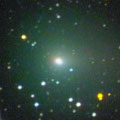
|
Now it is so bright as 6.0 mag (Nov. 8, Seiichi Yoshida). It will pass only 0.4 A.U. from the earth, and 0.8 A.U. from the sun in November and December, and will brighten up to 4-5 mag. In the Northern Hemisphere, it keeps observable in excellent condition for a long time until 2014 autumn when the comet will fade out. In the Southern Hemisphere, it is not be observable from mid November to early February.
Date(TT) R.A. (2000) Decl. Delta r Elong. m1 Best Time(A, h)
Nov. 9 8 59.38 21 22.6 0.486 1.144 95 6.0 3:15 (218, 24)
Nov. 16 10 24.14 33 36.2 0.408 1.061 88 5.1 3:07 (223, 5)
|
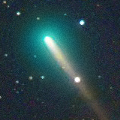
|
Now it is 8.0 mag (Nov. 7, Mike Linnolt). It will approach to the sun down to only 0.01 A.U. on Nov. 28, and is expected to be a great comet. But actually, it is fainter than originally expected by 3 mag. It will be 3 mag at best when it is observable in the morning sky. The brightness evolution is getting slower recently. The condition is excellent in the Northern Hemisphere. It keeps observable almost all through the period of brightening, at the highlight, and of fading. The condition is not good in the Southern Hemisphere. It is not observable at all the latter part of the highlight, and it keeps low all through the period.
Date(TT) R.A. (2000) Decl. Delta r Elong. m1 Best Time(A, h)
Nov. 9 12 1.03 -0 4.9 1.024 0.792 46 7.3 3:15 (266, 6)
Nov. 16 13 2.83 -8 8.0 0.894 0.589 36 6.0 3:07 (278, 2)
|
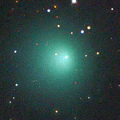
|
It brightened rapidly as expected. Now it is so bright as 7.0 mag (Nov. 8, Salvador Aguirre). It will pass the perihelion on Nov. 21, and will brighten up to 7 mag. In the Northern Hemisphere, it keeps observable in good condition in the morning sky until mid November. But it will be getting lower rapidly after this. It is not observable in the Southern Hemisphere.
Date(TT) R.A. (2000) Decl. Delta r Elong. m1 Best Time(A, h)
Nov. 9 13 22.81 -1 45.2 0.757 0.473 27 7.4 3:15 (279,-10)
Nov. 16 14 1.77 -9 55.3 0.939 0.370 21 7.1 3:07 (289, -9)
|
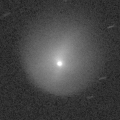
|
Although it was predicted to be 14 mag, it is extremely bright as 7.9 mag in outburst now (Nov. 8, Sandor Szabo). The round dust shell is expanding and getting diffuse. It will be observable in excellent condition in 2014 spring. In the Northern Hemisphere, it will be getting higher gradually in the morning sky. In the Southern Hemisphere, it is not observable until 2014 February.
Date(TT) R.A. (2000) Decl. Delta r Elong. m1 Best Time(A, h)
Nov. 9 13 53.76 21 31.2 2.752 2.111 41 8.4 3:15 (263,-29)
Nov. 16 14 12.92 20 14.2 2.668 2.054 42 8.5 3:07 (264,-29)
|
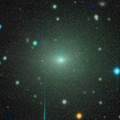
|
It brightened very rapidly. Now it is so bright as 10.8 mag (Nov. 4, Alexandre Amorim). It keeps bright as 10 mag from autumn to winter. In the Northern Hemipshere, it keeps observable in excellent condition until the comet fades out. In the Southern Hemisphere, it keeps observable in good condition within 2013, but it will not be observable in 2014. Uwe Pilz reported it is so bright as 7.7 mag on Oct. 30.
Date(TT) R.A. (2000) Decl. Delta r Elong. m1 Best Time(A, h)
Nov. 9 22 10.97 3 7.2 1.039 1.650 108 11.0 20:13 (151, 48)
Nov. 16 22 19.03 5 6.6 1.078 1.634 104 10.8 20:22 (143, 43)
|
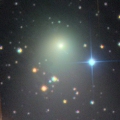
|
It became much brighter than expected, and reached up to 8.5 mag (Aug. 15, Alexandre Amorim). Now it is fading, but it is bright as 10.7 mag still now (Nov. 5, Alexandre Amorim). In the Southern Hemisphere, it will keep observable in good condition for a long time until 2014 summer when the comet fades out. It will never be observable again in the Northern Hemisphere.
Date(TT) R.A. (2000) Decl. Delta r Elong. m1 Best Time(A, h)
Nov. 9 11 58.51 -52 55.3 2.345 1.870 50 10.9 3:15 (316, 31)
Nov. 16 12 24.17 -55 34.7 2.409 1.930 50 11.2 3:07 (319, 31)
|
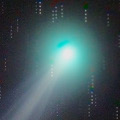
|
It approached to the sun down to 0.73 A.U. on Mar. 24, and brightened up to 4.7 mag (Mar. 11, Michael Mattiazzo). Now it is fading. But it is still bright as 11.9 mag (Oct. 30, Jakub Cerny). In the Northern Hemisphere, it keeps observable in good condition while fading gradually. In the Southern Hemisphere, it will never be observable again.
Date(TT) R.A. (2000) Decl. Delta r Elong. m1 Best Time(A, h)
Nov. 9 18 57.45 51 1.1 3.466 3.533 85 13.1 20:13 (143,-14)
Nov. 16 19 3.74 50 12.8 3.580 3.613 84 13.3 20:22 (139,-18)
|
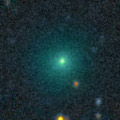
|
Now it is 11.8 mag (Nov. 8, Sandor Szabo). It keeps 11-13 mag until autumn, but it keeps locating extremely low in the morning sky.
Date(TT) R.A. (2000) Decl. Delta r Elong. m1 Best Time(A, h)
Nov. 9 12 8.92 -13 40.1 2.321 1.694 40 13.1 3:15 (279, 11)
Nov. 16 12 20.23 -16 54.5 2.338 1.764 43 13.3 3:07 (280, 15)
|
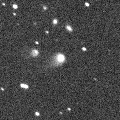
|
Now it is 14.0 mag and visible visually (Sept. 6, Sandor Szabo). It is expected to brighten up to 5-6 mag in 2014 autumn. In the Northern Hemisphere, it keeps observable in good condition for a long time, although it will be unobservable temporarily in late November. In the Southern Hemisphere, it will not be observable until 2014 February.
Date(TT) R.A. (2000) Decl. Delta r Elong. m1 Best Time(A, h)
Nov. 9 15 51.37 10 56.9 4.864 4.046 30 13.5 20:13 ( 85,-26)
Nov. 16 15 54.87 10 37.5 4.796 3.973 30 13.4 20:22 ( 80,-33)
|
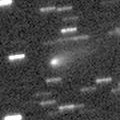
|
First return of a new periodic comet discovered in 1998. It brightened up to 10 mag at the discovery. Now it is 14.7 mag (Nov. 8, Sandor Szabo). In the Northern Hemisphere, it keeps observable in excellent condition from autumn to spring. A bit fainter than originally expected, but it will brighten up to 12 mag. It locates somewhat low in the Southern Hemisphere.
Date(TT) R.A. (2000) Decl. Delta r Elong. m1 Best Time(A, h)
Nov. 9 6 50.94 41 44.5 1.742 2.441 124 13.9 3:15 (185, 13)
Nov. 16 6 53.52 41 42.2 1.652 2.412 130 13.7 3:07 (181, 13)
|

|
Now it is 12.3 mag (Oct. 30, Jakub Cerny). It keeps bright at 13-14 mag for a long time until 2014. It keeps observable for a long time in the Northern Hemisphere. It locates somewhat low in the Southern Hemisphere.
Date(TT) R.A. (2000) Decl. Delta r Elong. m1 Best Time(A, h)
Nov. 9 19 16.82 11 30.3 6.286 6.025 70 13.7 20:13 (116, 15)
Nov. 16 19 18.04 10 32.3 6.395 6.035 64 13.7 20:22 (109, 9)
|
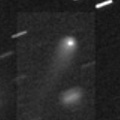
|
Now it is 13.3 mag and visible visually (Nov. 8, Sandor Szabo). It keeps 13-14 mag and observable in good condition in the Northern Hemisphere for a long time from 2013 to 2014. In the Southern Hemisphere, it is not observable until 2014 autumn.
Date(TT) R.A. (2000) Decl. Delta r Elong. m1 Best Time(A, h)
Nov. 9 11 49.96 71 36.2 3.260 3.470 93 13.8 3:15 (201,-30)
Nov. 16 12 12.50 74 35.0 3.182 3.463 98 13.8 3:07 (198,-31)
|

|
New bright comet. Now it is 12.7 mag (Nov. 8, Sandor Szabo). Very diffuse. It keeps 13-14 mag until late December. It is observable in excellent condition in the Northern Hemisphere. It locates somewhat low in the Southern Hemisphere.
Date(TT) R.A. (2000) Decl. Delta r Elong. m1 Best Time(A, h)
Nov. 9 9 4.34 7 15.1 0.990 1.403 90 13.9 3:15 (229, 34)
Nov. 16 9 24.07 9 58.6 0.961 1.419 93 13.9 3:07 (227, 32)
|

|
It brightened up to 11-12 mag in 2012. Now it is bright as 13.7 mag (July 24, Taras Prystavski). In the Northern Hemisphere, it is appearing in the morning sky again. In the Southern Hemisphere, it will be observable again after mid December.
Date(TT) R.A. (2000) Decl. Delta r Elong. m1 Best Time(A, h)
Nov. 9 13 26.29 -12 57.0 7.565 6.658 22 14.0 3:15 (289, -4)
Nov. 16 13 27.57 -13 12.9 7.540 6.690 28 14.0 3:07 (287, -1)
|

|
Big asteroid discovered in 1906. It suddenly showed the cometary activity on Dec. 11, 2010, probably due to an impact of a small object. It has already turned to be stellar.
Date(TT) R.A. (2000) Decl. Delta r Elong. m1 Best Time(A, h)
Nov. 9 0 11.34 -16 55.2 2.429 3.129 127 14.1 20:56 (180, 72)
Nov. 16 0 9.68 -16 17.3 2.518 3.139 120 14.2 20:27 (180, 71)
|

|
Not observable now. It will appear in the morning sky again in late December.
Date(TT) R.A. (2000) Decl. Delta r Elong. m1 Best Time(A, h)
Nov. 9 14 47.61 -24 35.3 7.164 6.185 8 14.2 3:15 (311,-11)
Nov. 16 14 53.30 -24 59.4 7.156 6.183 9 14.2 3:07 (309, -8)
|
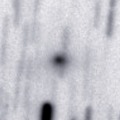
|
It brightened up to 2 mag by unusual major outburst in 2007. It will return in 2014. It will be 14 mag at best by normal prediction. But actually, it is brighter than predicted. It has already brightened up to 15.3 mag (Oct. 26, J. F. Hernandez).
Date(TT) R.A. (2000) Decl. Delta r Elong. m1 Best Time(A, h)
Nov. 9 18 50.26 -30 2.8 2.743 2.316 54 15.0 20:13 ( 74, 33)
Nov. 16 19 4.08 -29 1.0 2.787 2.293 50 14.8 20:22 ( 73, 28)
|
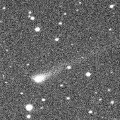
|
Now it is 14.3 mag (July 8, Chris Wyatt). It keeps bright as 13-14 mag for a long time from 2013 to 2014. Now it is not observable. But it will appear in the morning sky again in 2014 February.
Date(TT) R.A. (2000) Decl. Delta r Elong. m1 Best Time(A, h)
Nov. 9 16 19.42 -23 8.7 4.040 3.131 20 15.0 20:13 ( 62, 0)
Nov. 16 16 30.85 -23 42.9 4.061 3.124 16 14.9 20:22 ( 57, -4)
|
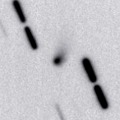
|
Now it is 15.5 mag (Oct. 18, F. Garcia). It is expected to brighten up to 7.5 mag and to be observable in excellent condition from summer to autumn in 2014 in the Southern Hemisphere. The condition is bad in the Northern Hemisphere. It will pass extremely close to Mars in 2014 October.
Date(TT) R.A. (2000) Decl. Delta r Elong. m1 Best Time(A, h)
Nov. 9 5 0.21 -35 1.1 3.901 4.485 120 15.2 1:48 (180, 90)
Nov. 16 4 50.00 -36 19.2 3.821 4.418 121 15.1 1:11 ( 0, 89)
|

|
Now it is 14.9 mag and visible visually (Nov. 8, Sandor Szabo). It keeps 14 mag for a long time until 2014 summer. It keeps observable in good condition in the Northern Hemisphere. It is observable only until February in the Southern Hemisphere.
Date(TT) R.A. (2000) Decl. Delta r Elong. m1 Best Time(A, h)
Nov. 9 4 54.37 -14 45.0 1.825 2.639 137 15.5 1:43 (180, 70)
Nov. 16 4 43.88 -13 50.3 1.723 2.576 142 15.3 1:05 (180, 69)
|
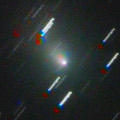
|
It brightened up to 9-10 mag in 2013 spring. Now it is fading. It has already faded down to 15.8 mag (Oct. 7, Hidetaka Sato). In the Southern Hemisphere, it keeps observable for a long time until the comet fades out, although it keeps locating low. It will never be observable again in the Northern Hemisphere.
Date(TT) R.A. (2000) Decl. Delta r Elong. m1 Best Time(A, h)
Nov. 9 13 31.35 -60 52.5 3.408 2.822 46 15.3 3:15 (329, 23)
Nov. 16 13 54.29 -61 50.9 3.489 2.891 45 15.5 3:07 (331, 23)
|
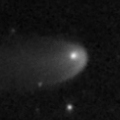
|
Now it is 15.7 mag (Oct. 11, Ken-ichi Kadota). It keeps 15 mag and observable in good condition in 2013. It locates somewhat low in the Northern Hemisphere.
Date(TT) R.A. (2000) Decl. Delta r Elong. m1 Best Time(A, h)
Nov. 9 3 41.17 -25 41.1 6.555 7.301 136 15.4 0:30 (180, 81)
Nov. 16 3 36.45 -25 26.4 6.592 7.333 135 15.4 23:53 (180, 80)
|
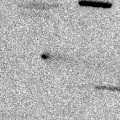
|
Now it is 16.3 mag (Oct. 21, V. Benishek, B. Benishek). It tends to be brightest 4 months after the perihelion passage. It will reach up to 15.5 mag from autumn to winter, and will be observable in excellent condition.
Date(TT) R.A. (2000) Decl. Delta r Elong. m1 Best Time(A, h)
Nov. 9 6 42.55 16 31.6 1.326 2.070 126 15.8 3:15 (185, 38)
Nov. 16 6 42.49 16 43.8 1.294 2.097 133 15.7 3:03 (180, 38)
|
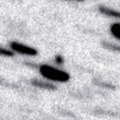
|
It reaches up to 12 mag in 2014 spring. But the condition in this apparition is bad. It locates low around the brightest days. Now it is 16.4 mag (Oct. 9, J. L. Martin). It keeps observable in good condition until winter when the comet will brighten up to 15-16 mag.
Date(TT) R.A. (2000) Decl. Delta r Elong. m1 Best Time(A, h)
Nov. 9 19 48.23 -13 32.8 2.656 2.499 70 16.0 20:13 ( 99, 36)
Nov. 16 19 57.61 -13 29.2 2.698 2.456 65 15.9 20:22 ( 95, 31)
|

|
It approached to the sun down to 0.14 A.U. on Oct. 7. In the Northern Hemisphere, it keeps observable at 16 mag in good condition from late October to mid December. In the Southern Hemisphere, it locates very low from November to December.
Date(TT) R.A. (2000) Decl. Delta r Elong. m1 Best Time(A, h)
Nov. 9 18 44.32 6 6.2 0.668 0.884 60 15.9 20:13 (107, 13)
Nov. 16 19 44.47 8 35.8 0.739 1.007 69 16.0 20:22 (113, 15)
|
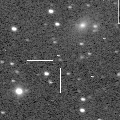
|
It is expected to brighten up to 13 mag and to be observable in excellent condition from spring to summer in 2014. Appearing in the morning sky. It has not been observed since May. But it must be already brightening up to 16.5 mag.
Date(TT) R.A. (2000) Decl. Delta r Elong. m1 Best Time(A, h)
Nov. 9 12 3.69 -2 34.7 3.625 3.004 44 16.2 3:15 (269, 6)
Nov. 16 12 13.61 -3 36.1 3.529 2.976 49 16.1 3:07 (268, 9)
|

|
It brightened up to 12 mag in 2012. It is bright as 15.3 mag still now (Oct. 13, Ken-ichi Kadota). It will be fading and getting lower after this, and will be unobservable at 17 mag in December.
Date(TT) R.A. (2000) Decl. Delta r Elong. m1 Best Time(A, h)
Nov. 9 20 5.86 -33 1.4 3.430 3.238 70 16.1 20:13 ( 78, 49)
Nov. 16 20 14.81 -32 27.8 3.534 3.253 65 16.2 20:22 ( 76, 43)
|

|
Brightened rapidly. Now it is visible visually at 14.3 mag (Oct. 11, Seiichi Yoshida). It keeps observable in excellent condition until autumn. Some visual observers reported it extremely bright as 12 mag in August.
Date(TT) R.A. (2000) Decl. Delta r Elong. m1 Best Time(A, h)
Nov. 9 21 46.70 5 43.6 1.822 2.270 103 16.1 20:13 (145, 43)
Nov. 16 21 55.80 6 7.0 1.915 2.292 99 16.3 20:22 (137, 39)
|
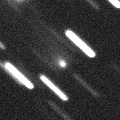
|
It brightened up to 14.5 mag in July (July 16, M. Brusa, L. Sempio). Now it is fading. In the Southern Hemisphere, it keeps observable for a long time until the comet fades out. It is not observable in the Northern Hemisphere.
Date(TT) R.A. (2000) Decl. Delta r Elong. m1 Best Time(A, h)
Nov. 9 17 59.83 -45 51.0 2.991 2.439 47 16.3 20:13 ( 52, 30)
Nov. 16 18 4.45 -46 59.3 3.092 2.465 43 16.4 20:22 ( 49, 25)
|

|
The condition is worst and the comet will be hardly observable in this apparition. Now it is appearing in the morning sky in the Northern Hemisphere. Now it is 17.8 mag (Oct. 31, Jean-Francois Soulier).
Date(TT) R.A. (2000) Decl. Delta r Elong. m1 Best Time(A, h)
Nov. 9 12 54.91 3 18.7 2.541 1.836 36 16.5 3:15 (271, -8)
Nov. 16 13 8.36 2 8.7 2.552 1.896 39 16.9 3:07 (271, -6)
|

|
Now it is 16.8 mag (Nov. 2, J. F. Hernandez). It will brighten rapidly and will be observable at 15 mag in winter in excellent condition in the Northern Hemisphere. It locates low in the Southern Hemisphere.
Date(TT) R.A. (2000) Decl. Delta r Elong. m1 Best Time(A, h)
Nov. 9 4 42.55 40 34.7 1.182 2.084 146 16.7 1:31 (180, 14)
Nov. 16 4 39.15 41 13.9 1.124 2.052 152 16.5 1:00 (180, 14)
|
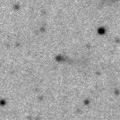
|
Now it is 17.2 mag (Oct. 9, C. Bell). It keeps 17 mag for a long time from 2013 summer to early 2015.
Date(TT) R.A. (2000) Decl. Delta r Elong. m1 Best Time(A, h)
Nov. 9 1 47.34 14 56.8 2.160 3.122 163 16.6 22:32 (180, 40)
Nov. 16 1 43.72 14 22.9 2.187 3.113 155 16.6 22:01 (180, 41)
|

|
Now it is 16.8 mag (Nov. 6, G. Borisov, O. Bryzgalov). It keeps 15 mag for a long time from 2014 summer to 2015 summer. It keeps observable in good condition in the Northern Hemisphere. It becomes observable only after 2015 in the Southern Hemisphere.
Date(TT) R.A. (2000) Decl. Delta r Elong. m1 Best Time(A, h)
Nov. 9 5 38.05 48 20.9 3.657 4.408 134 16.8 2:26 (180, 7)
Nov. 16 5 34.54 49 18.6 3.560 4.362 139 16.7 1:56 (180, 6)
|
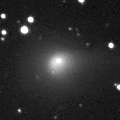
|
Fading slowly. It is bright as 15.1 mag still now (Nov. 1, Yasukazu Ikari). It keeps observable in good condition until the comet will be fainter than 18 mag in December.
Date(TT) R.A. (2000) Decl. Delta r Elong. m1 Best Time(A, h)
Nov. 9 0 37.90 -4 27.1 2.619 3.435 139 17.0 21:23 (180, 59)
Nov. 16 0 36.57 -4 47.8 2.762 3.505 132 17.2 20:54 (180, 60)
|
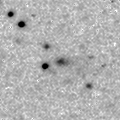
|
Now it is 17.6 mag (Oct. 11, A. Smolin). It will be observable at 17 mag in excellent condition from autumn to winter.
Date(TT) R.A. (2000) Decl. Delta r Elong. m1 Best Time(A, h)
Nov. 9 2 55.84 19 12.5 1.613 2.603 177 17.0 23:40 (180, 36)
Nov. 16 2 51.55 18 33.6 1.616 2.599 172 17.0 23:08 (180, 36)
|
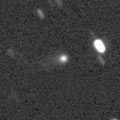
|
It was observed at 15-16 mag in 2012. Now it is fading slowly. But it keeps 15.6 mag still now (Oct. 13, Catalina Sky Survey). It will be fainter than 18 mag at the end of 2013. It locates low in the Southern Hemisphere.
Date(TT) R.A. (2000) Decl. Delta r Elong. m1 Best Time(A, h)
Nov. 9 0 28.09 20 27.5 3.971 4.814 144 17.1 21:13 (180, 35)
Nov. 16 0 22.79 18 43.3 4.084 4.854 137 17.2 20:40 (180, 36)
|
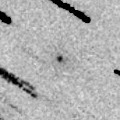
|
Although it had been fainter than expected, it is brightening now. Probably it tends to be brightest after the perihelion passage. Now it is 17.0 mag (Oct. 7, D. Buczynski). It keeps observable at 17-18 mag until December. It locates somewhat low in the Southern Hemisphere.
Date(TT) R.A. (2000) Decl. Delta r Elong. m1 Best Time(A, h)
Nov. 9 5 9.73 24 49.5 0.873 1.791 147 17.1 1:58 (180, 30)
Nov. 16 5 3.00 24 33.4 0.887 1.836 156 17.2 1:24 (180, 30)
|
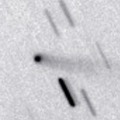
|
Now it is 16.4 mag (Oct. 14, Catalina Sky Survey). It will be observable at 16 mag in good condition in summer and autumn.
Date(TT) R.A. (2000) Decl. Delta r Elong. m1 Best Time(A, h)
Nov. 9 0 11.75 5 40.5 1.608 2.437 138 17.2 20:57 (180, 49)
Nov. 16 0 13.63 4 35.9 1.695 2.462 131 17.3 20:31 (180, 50)
|
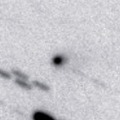
|
First return of a new periodic comet discovered in 1998. Now it is 17.6 mag (Oct. 4, K. Hills). It is fainter than originally expected by 2 mag. It was expected to be observable at 15.5 mag in good condition from 2013 autumn to early 2014. But actually, it will be 17 mag at best.
Date(TT) R.A. (2000) Decl. Delta r Elong. m1 Best Time(A, h)
Nov. 9 1 43.76 -25 0.6 1.832 2.625 134 17.2 22:28 (180, 80)
Nov. 16 1 40.07 -23 59.1 1.859 2.609 130 17.2 21:57 (180, 79)
|
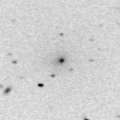
|
It brightened rapidly, and it keeps bright as 16.0 mag still now (Oct. 7, Hidetaka Sato). It will be fading after this. But it may keep 16 mag some more time. It will be getting higher gradually in the Southern Hemisphere. But it keeps locating extremely low in the Northern Hemisphere.
Date(TT) R.A. (2000) Decl. Delta r Elong. m1 Best Time(A, h)
Nov. 9 10 32.75 -41 54.2 2.723 2.405 61 17.3 3:15 (298, 42)
Nov. 16 10 23.34 -44 11.3 2.664 2.448 66 17.5 3:07 (300, 48)
|
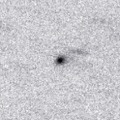
|
Now it is 17.4 mag (Sept. 25, Catalina Sky Survey). Brighter than origianlly predicted. It will be observable at 12-13 mag in excellent condition from 2014 summer to 2015 spring. In the Southern Hemisphere, it will locate low around the highlight.
Date(TT) R.A. (2000) Decl. Delta r Elong. m1 Best Time(A, h)
Nov. 9 0 16.97 -8 7.5 2.647 3.405 133 17.4 21:02 (180, 63)
Nov. 16 0 14.34 -7 57.9 2.689 3.367 126 17.4 20:32 (180, 63)
|

|
Now it is 18.6 mag (Oct. 13, Ken-ichi Kadota). It will brighten up to 14 mag around the perihelion passage in 2019. In 2013, it will be observable in good condition at 18 mag from summer to winter. It locates low in the Southern Hemisphere.
Date(TT) R.A. (2000) Decl. Delta r Elong. m1 Best Time(A, h)
Nov. 9 2 56.97 27 13.3 12.787 13.762 169 17.4 23:41 (180, 28)
Nov. 16 2 54.85 27 12.9 12.761 13.734 169 17.4 23:12 (180, 28)
|

|
It brightened up to 12-13 mag from autumn to winter in 2012. Now it is fading. It has already faded down to 16.8 mag (Nov. 8, P. C. Sherrod). It keeps observable for a long time until the end of 2013 when the comet becomes fainter than 18 mag.
Date(TT) R.A. (2000) Decl. Delta r Elong. m1 Best Time(A, h)
Nov. 9 6 10.59 2 19.3 3.757 4.461 130 17.5 2:59 (180, 53)
Nov. 16 6 8.22 1 27.6 3.736 4.504 136 17.5 2:29 (180, 54)
|
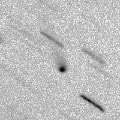
|
Now it is 17.1 mag (Oct. 12, Toshiyuki Takahashi). It was observed at 18 mag in 2012. It will be observable at 17 mag in excellent condition in 2013.
Date(TT) R.A. (2000) Decl. Delta r Elong. m1 Best Time(A, h)
Nov. 9 22 47.82 -11 18.9 4.013 4.486 112 17.5 20:13 (156, 65)
Nov. 16 22 44.73 -12 27.5 4.153 4.501 104 17.6 20:22 (136, 61)
|
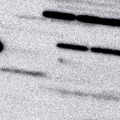
|
Now it is 17.8 mag (Oct. 11, Ken-ichi Kadota). It keeps observable at 17.5 mag in good condition from autumn to winter.
Date(TT) R.A. (2000) Decl. Delta r Elong. m1 Best Time(A, h)
Nov. 9 7 27.07 17 10.1 1.513 2.137 115 17.7 3:15 (198, 36)
Nov. 16 7 29.69 17 33.4 1.467 2.161 122 17.7 3:07 (193, 37)
|
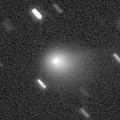
|
It brightened up to 9.0 mag in 2012 autumn (Nov. 4, Juan Jose Gonzalez). However, it faded out unexpectedly around the perihelion passage. Now it is fainter than originally predicted by 4-5 mag. It has already faded down to 17.4 mag (Oct. 1, K. Hills). In the Southern Hemisphere, it keeps observable in good condition while fading slowly after this. In the Northern Hemisphere, it will not be observable after this.
Date(TT) R.A. (2000) Decl. Delta r Elong. m1 Best Time(A, h)
Nov. 9 3 1.09 -52 44.1 3.506 3.963 110 17.8 23:45 ( 0, 72)
Nov. 16 2 52.68 -51 51.5 3.592 4.025 109 17.9 23:09 ( 0, 73)
|
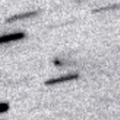
|
Now it is 18.7 mag (Sept. 27, Yasukazu Ikari). It was expected to brighten up to 16.5 mag from autumn to winter. But actually, it seems to be already fading.
Date(TT) R.A. (2000) Decl. Delta r Elong. m1 Best Time(A, h)
Nov. 9 3 8.64 9 6.3 1.180 2.165 171 17.8 23:53 (180, 46)
Nov. 16 3 4.86 7 48.0 1.181 2.159 168 17.9 23:22 (180, 47)
|
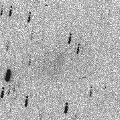
|
It will approach to the Sun down to 0.9 A.U., and to the Earth down to 0.4 A.U. in September. So it was expected to brighten up to 11-12 mag. However, it looked extremely diffuse on July 12 by Michael Jager. So the comet could be already disintegrated at that time. No observations have been reported after that. It keeps locating in good condition after this in the Southern Hemisphere. It is not observable in the Northern Hemisphere.
Date(TT) R.A. (2000) Decl. Delta r Elong. m1 Best Time(A, h)
Nov. 9 0 15.86 -62 17.0 1.030 1.488 94 22.7 21:03 ( 0, 63)
Nov. 16 0 37.71 -58 48.0 1.137 1.574 95 23.1 20:56 ( 0, 67)
|
|
![]()
 C/2006 S3 ( LONEOS )
C/2006 S3 ( LONEOS ) (596) Scheila
(596) Scheila 29P/Schwassmann-Wachmann 1
29P/Schwassmann-Wachmann 1 17P/Holmes
17P/Holmes 117P/Helin-Roman-Alu 1
117P/Helin-Roman-Alu 1 C/2013 A1 ( Siding Spring )
C/2013 A1 ( Siding Spring ) C/2013 V1 ( Boattini )
C/2013 V1 ( Boattini ) C/2012 L2 ( LINEAR )
C/2012 L2 ( LINEAR ) C/2009 F4 ( McNaught )
C/2009 F4 ( McNaught ) 84P/Giclas
84P/Giclas 4P/Faye
4P/Faye (3200) Phaethon
(3200) Phaethon 134P/Kowal-Vavrova
134P/Kowal-Vavrova 246P/2010 V2 ( NEAT )
246P/2010 V2 ( NEAT ) P/2013 J2 ( McNaught )
P/2013 J2 ( McNaught ) C/2012 S3 ( PanSTARRS )
C/2012 S3 ( PanSTARRS ) 46P/Wirtanen
46P/Wirtanen 52P/Harrington-Abell
52P/Harrington-Abell 119P/Parker-Hartley
119P/Parker-Hartley C/2013 V2 ( Borisov )
C/2013 V2 ( Borisov ) C/2013 E2 ( Iwamoto )
C/2013 E2 ( Iwamoto ) 291P/2013 N2 ( NEAT )
291P/2013 N2 ( NEAT ) C/2012 A2 ( LINEAR )
C/2012 A2 ( LINEAR ) 184P/Lovas 2
184P/Lovas 2 257P/2012 F4 ( Catalina )
257P/2012 F4 ( Catalina ) 292P/2013 O1 ( Li )
292P/2013 O1 ( Li ) C/2013 G6 ( Lemmon )
C/2013 G6 ( Lemmon ) 32P/Comas Sola
32P/Comas Sola C/2010 U3 ( Boattini )
C/2010 U3 ( Boattini ) C/2012 J1 ( Catalina )
C/2012 J1 ( Catalina ) C/2012 S4 ( PanSTARRS )
C/2012 S4 ( PanSTARRS ) 178P/Hug-Bell
178P/Hug-Bell C/2011 F1 ( LINEAR )
C/2011 F1 ( LINEAR ) P/2013 O2 ( PanSTARRS )
P/2013 O2 ( PanSTARRS ) C/2013 G5 ( Catalina )
C/2013 G5 ( Catalina )![]()









































